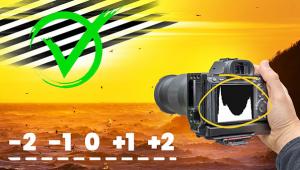Konica Minolta’s DiMAGE Scan Elite 5400 II; The Best 35mm Scanner Gets Better And More Affordable Page 2
Initially I chose to adjust, color correct, and edit these raw files using Adobe's Photoshop Elements 3.0. And, I found by beginning by using Levels to optimize the gamut, and then going to Elements' Quick Fix using the manual sliders to adjust contrast and color, I could achieve a quite refined, finished image rather easily, and even more efficiently than using the full CS version of Photoshop. However, if you are working with a really big file, even with a fast computer, the processing of each adjustment takes time. And correcting each dimension of image quality separately, reprocessing the entire file each time, is not an ideal way to finish scans if you have more than just a few images to adjust and edit.
Fortunately, I had recently acquired the latest version of LaserSoft's
SilverFast HDR Studio. This HDR version of SilverFast is just like their scanner
drivers, but it is designed to open and process high-bit raw images using the
same tools and processes as are available in their scanner driver Ai 6 versions
of SilverFast. There are two main advantages HDR offers over using Photoshop
to adjust and color correct raw image files. One is that SilverFast only opens
a relatively small proxy preview image from the whole 220MB file, so as you
work with it the system is not taxed by processing all of the data in that big
220MB file. And two, you can apply all of the adjustments using the SilverFast
tools consecutively, and cumulatively. This allows you to adjust each dimension
of image quality to get to a finished image result in a continuous flow, including
sharpening and if necessary using SilverFast's own GANE grain and noise
reduction and ACR color restoration facilities. Once done you then click on
the Process button and all of these accumulated color corrections and editing
adjustments are applied simultaneously and quite quickly, outputting a fully
finished 24-bit file.
In addition, I should add that when scanning Kodachrome or silver-based black
and white film to a high-bit raw file you must turn Digital ICE off in the Konica
Minolta Utility. Then, if you are using LaserSoft's SilverFast--either
the scanner driver Ai 6 or the HDR version I used--it has a quite effective
SilverFast SRD dust and scratch removal utility built-in, which is very effective
at cleaning most of the defects in Kodachrome and black and white images. However,
with very grainy black and white or the high-speed, grainy Kodachrome 200, it
is less effective.
 |
|
|
Observations From The Processing And Final Image Results
Because of its speed and efficiency, I was able to get a quantity of high-resolution
scans done in a short time. This allowed me to experiment with various types
of images. As I mentioned at the outset, I began with a selection of film images
which were really culls, images I had never used in the past because they were
overexposed or underexposed, contained unacceptable color casts due to processing
and other errors, or were made in lighting conditions that produced undesirable
image color and contrast. What was most evident working with these less-than-optimum
images was that the greater specification depth and new light source and optics
of the scanner produced raw scan image data with much more latitude for correction
and adjustment.
A couple of examples may better support this observation. On one of my visits
to the ghost town of Bodie, California, which is at a very high altitude, I
brought along some Technical Ektachrome, originally intended for microscope
slides, thus configured with very high contrast and saturation. I exposed a
couple of rolls of this film midday in Bodie in the summer, and the resulting
slide film had a huge blue shift that I assumed was the result of mixing high
saturation and contrast and the excessively cold color temperature light at
such high altitudes.
Anyway, after making a raw scan and opening the file in SilverFast HDR I was
able to correct for the excessive blue and restore a balance of color to render
the natural colors of the scene to near normal. Attempts with these images on
Technical Ektachrome in the past had always failed. In another image, again
shot at high altitude on an overcast day, although the slide was not as grossly
blue, just removing the color cast resulted in a very dull image. However, by
then overcompensating, making the color balance much warmer and pushing the
saturation almost to the limit, I was able to reproduce an image file that looked
plausible, and could have been a natural result if the light had been warmer.
Stretching color correction that far, well beyond neutral to the opposite tack,
is something I have not found to be as effective in the past.
Most of the cull images I began my testing with did not require such large color
corrections; for the most part the issues with them had to do with overexposure
and underexposure and "unfortunate" lighting. This was easier, even
more so than I have been used to in the past. The 5400 II gets more and better
image information out of both highlights and shadows, providing much more effective
adjustment of local contrast. The result is that you can reproduce detail and
tonal separation smoothly all across the density spectrum in the finished image.
In other words, the raw scan just gets more and better image information equally
across the entire density range of the film original. If the original film is
a bit overexposed, whatever highlight information is in the film will be recorded
more completely than was possible with the previous model 5400. And, with an
underexposed film image, the same is true of the shadows. This may make for
some grain noise, however, particularly with older Ektachrome-type films, as
I've noticed that dye deterioration from age seems to affect shadow densities
most of all. Although the 5400 II supports multi-pass scanning it did not reduce
the grain noise in shadows. However, the Kodak/ASF Digital GEM utility can be
quite effective in eliminating or reducing this shadow grain noise.
 |
|
|
When I got to scanning black and white and Kodachrome with Digital ICE turned
off to output high-bit files, each scan was done very quickly. In the past,
getting good shadow detail from Kodachrome has been a challenge, due to the
film's high D-max. This was less of a problem with the new 5400 II. On
the other hand, although the new model scans black and white effectively, the
film's lower density range compared to slide film requires spreading the
image values out further to fill the gamut, and then using adjustments to local
contrast very carefully to obtain both good tonal separation and smooth gradations
in the final image file.
My final selection of film images for this test were made up of good quality
photos that had been scanned before; here I did not really expect dramatic differences
in results. Although the differences in my final scans of these select images
were subtle, they were significant nonetheless. The most important improvement
was in better shadow and highlight values, with more detail and a smoother gradation
of tones. I also noticed in the mid values tonal gradation was smoother with
shapes more clearly distinguished and variations in subject color more faithfully
and richly reproduced. As important as better results are, I found it even as
valuable that getting from a raw image to a corrected and ideally adjusted final
image file was more direct and efficient. So, when you add up all of the functional
advantages, including scan speed and more streamlined functioning, as well as
getting to a finished ideal image more directly and with less effort, the new
5400 II could be seen as an efficiency and production value advantage. The improved
scanned image quality is just cream on the top.
Conclusion And Recommendation
It is really no surprise that the next generation of a digital imaging product
is both better performing and less costly--that seems to be the nature
of technological progress. What was surprising to me is that Konica Minolta
made a major investment in an upgraded product, even though they were already
offering the best product for the price with the original 5400. They could have
sat on their laurels for at least another year, I'm sure. Digital darkroom
enthusiasts should be grateful to Konica Minolta and enthusiastic about the
new DiMAGE Scan Elite 5400 II. So my advice would be if you need the best in
a dedicated 35mm film scanner, this new Konica Minolta offering is as good as
it gets, at least for a while.
For those like me who purchased the first 5400 scanner, it might be a harder
decision whether or not to upgrade. However, I didn't think twice about
it being a good move and sent Konica Minolta a check rather than return the
scanner. A deserving friend will inherit my used 5400.
For more information and a full list of specifications, visit Konica Minolta's
website at: http://konicaminolta.us.
You can also contact the company at 725 Darlington Ave., Mahwah, NJ 07430; (800)
285-6422, (201) 574-4000.
- Log in or register to post comments

































